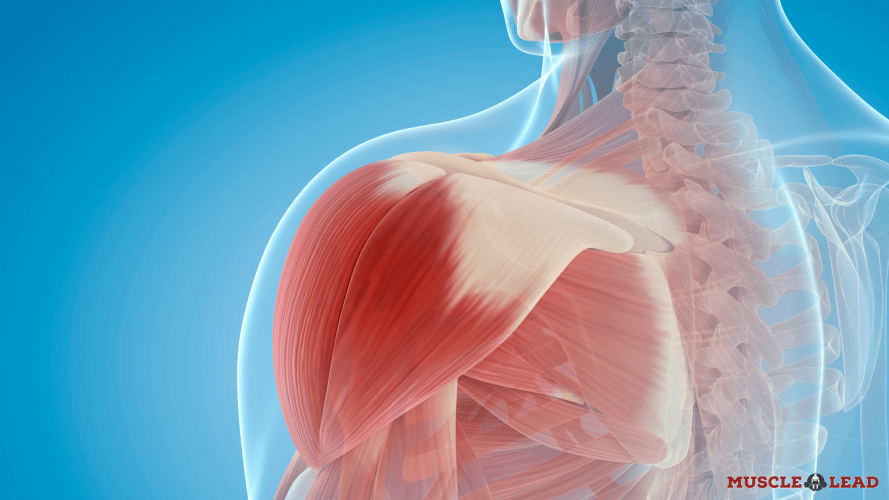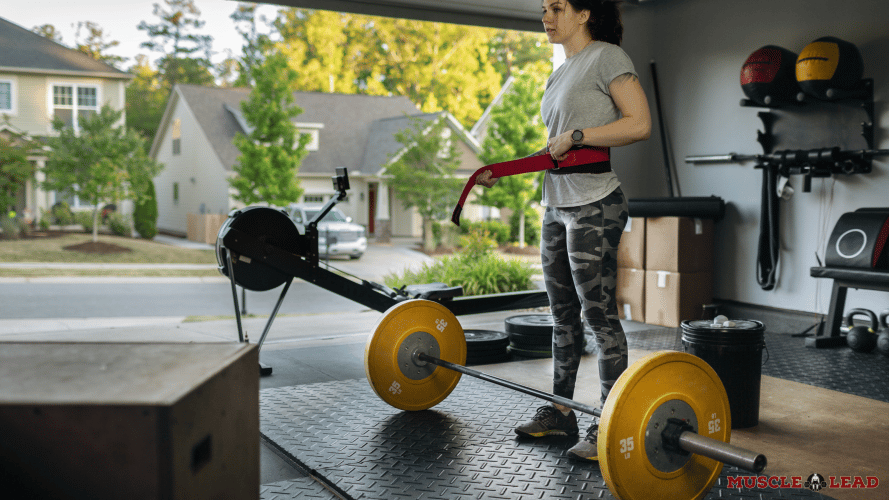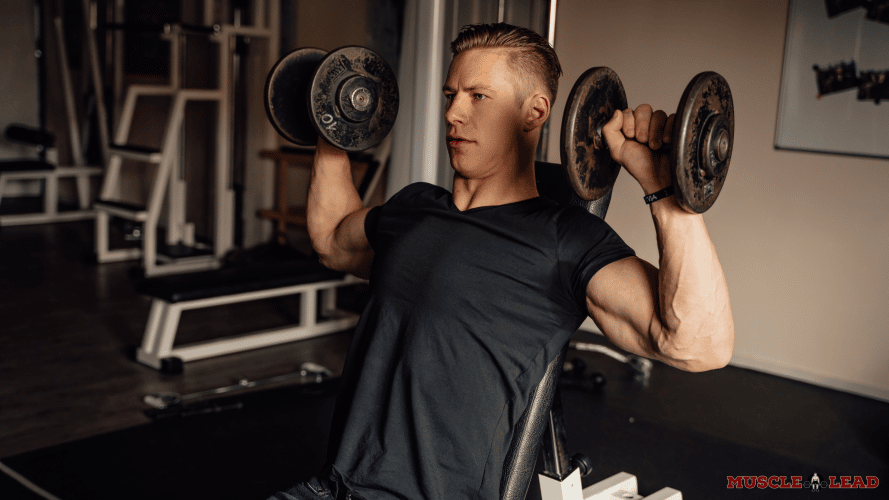My overhead press felt and moved so much better, as soon as I decided to invest in a weight lifting belt.
Have you given it a try yet?
To give you our expert opinion, we have covered all you need to know about the overhead press with a lifting belt.
So, do you need a lifting belt for overhead press? The short answer is no. However, some liters do find the belt can help with cues to breathe and brace during the overhead press. Some benefits include spine safety, stronger overhead press, better balance and stability, as well as more confidence.
We go over a step by step ‘how to’ guide, with an additional step to finalize the exercise.
Moving on, we have highlighted the 6 main muscle groups involved to perform the overhead press.
How To Do The Overhead Press?
We have put together a step by step guide that can be followed, to put you on track for some awesome overhead pressing.
STEP 1: Set up a barbell on top of a squat rack just under collar bone height. Load up the barbell in relation to your exercise level.
STEP 2: Connect your chest against the bar and grasp it shoulder width apart (double overhand). Plant the feet hip to shoulder width apart just underneath the bar
STEP 3: Take a deep breath down into the stomach and brace the core in a 360° manner. Press the feet off the ground, extend at the knees, and pop off the hips to get the bar off the rack.
STEP 4: With the bar on the front of the chest/shoulders take 2 steps back. Get ready to brace.
STEP 5: Breathout, take another deep breath. Then position the elbows in between being tucked into the body and flared out.
STEP 6: Hold the breath, then press the bar upwards until the elbows are almost fully straightened. Release the breath while bringing it back down.
Additional Information: Repeat the movement for as many reps planned, then re-rack at the same height by walking forward.
What Muscles Does The Overhead Press Work?: 6 Main Muscle Groups
There are many muscles that come together to perform the overhead press like the legs.
However, we will only discuss the 6 main muscles of the lift.
Shoulders
Pressing the bar above the head (shoulder abduction) should work the 3 parts of the shoulder which include the mid deltoids (middle) anterior deltoids (front) posterior deltoids (back).
From the nature of the bar position, the front deltoids would take most of the workload.
Other small shoulder muscles would also be expected to come into play like rotator cuffs. These muscles help stabilize the shoulder joint and rotate it in all directions.

Triceps
The triceps is a group of 3 muscles on the back of the arm. Their main function is to extend the elbow or better understood as straighten the lower arm.
Just for the sake of interest, these triceps muscles are called the later head (outer arm), long head (inner arm), and medial head (middle).
Can you pick out an elbow extension movement during the overhead press?
CORRECT!
The elbow movement or triceps help to press the bar up.
Upper Chest
The upper chest is connected to the collarbone and upper arm bone. So the movement that activates its muscle fibers is flexing the shoulders forwards.
With the elbow positioning of the overhead press, you can definitely expect it to hit the upper chest and perhaps define that area.
Core Stability Muscles
Last but not least, the core stability muscles surrounding the midsections are braced to help stay balanced and keep the spine in a safe and neutral position.
The core muscles Include the;
- Rectus Abdominis (six pack)
- External and Internal Obliques (side of the trunk)
- Diaphragm (stomach muscle)
- Transverse Abdominis (deep ab muscle)
- Erector Spinae (lower back stabilizer)
- Multifidus (large back stabilizer)
Does A Weightlifting Belt Make Your Core Weaker?
Trapezius
The trapezius is in the middle of the upper back. It might come as a surprise as to why this muscle is activated.
So upon pressing the bar upwards, the shoulder blade pin backwards and lifts upwards. While bringing the bar down the shoulder blades would sink downwards.
These 3 shoulder blade movements would hit the whole trapezius muscle group.
Grip Strength Muscles
To be able to put a tight grasp over the barbell the smaller muscles surrounding the hands and the slightly larger forearms get involved.
This is crucial, as a lift could easily drop the bar if the grip muscles are not strong enough.
What Can The Lifting Belt Do For Overhead Press?: 4 Benefits
There are 4 awesome benefits you could take advantage of by just wearing a lifting belt.
I have discussed these below.
Better Balance & Stability
The core stability muscles kick in to keep us balanced on our feet while standing or moving.
The overhead press demands a lot of balance, as you are literally balancing on your feet while pressing a weight above the head.
This is where the lifting belt comes into the equation. The lifting belt can draw the core stability muscles effectively.
This means that the belt could help keep a lifter balanced and stable to get the best out of the overhead press.
What happens if we lose balance?
Losing balance from not being able to keep the core muscles tight, would mess up the lifting energy.

Trying to regain stability mid set would take the tension off the working muscles.
So in other words, you would not be able to get the best strength and muscle building benefits from the lift.
In the worst case scenario, a lifter could fall over, followed by a blunt force Injury like fractured bones, strained muscles, or sprained joints.
Spine Safety
During the overhead press, the lower back is likely to bend backwards from the nature of the bar position and path bar, especially during the 3rd quarter of the lift.
This could bring out spinal injuries like spondylolysis and spondylolisthesis if the back is arches too much.
While walking forward to re-rack the bar puts the spine at risk of curving forward and being loaded.
Spinal loading has some serious consequences on thoracic (Upper) and lumber (lower) spine.
As we know, the lifting belt helps to brace the core stability muscles and build intra abdominal pressure.
While overhead pressing, bracing the core stability muscles in such a manner, could stop the spine from bending back, curving forward, and even twisting or bending to the side.
Stronger Overhead Press
You might be glad to learn that the lifting belt can actually make your overhead press stronger and work the muscles better.
Most of the lifting energy would be kept on the actual lift instead of losing it through a lack of balance spine movements.
In the longer term, this outcome could build stronger and bigger overhead press muscles groups.

More Lifting Confidence
Half the battle is in the mind. Most lifters do not have the confidence to get underneath the bar, especially at higher intensity.
Single Prong Vs Double Prong Lifting Belt – Which One is Best for You?
The lifting belt may give the reassurance of the lift being a lot safer to go through with the overhead press (2).
Final Thoughts
The overhead press is great free weight exercise that can strengthen and build the muscles of the upper body.
These muscles include the;
- Shoulders
- Triceps
- Upper Chest
- Core
- Trapezius
- Grip & Forearm Muscles
With the simple step by step guide you could include the overhead press into your workout program, either on shoulder or push day.
By simply wears a lifting belt you can reap out even more benefits including;
- Better Balance & Stability
- Spine Safety
- Stronger Overhead Press
- More Lifting Confidence
Final Verdict
Should you use the lifting belt for the overhead press?
ABSOLUTELY!!!
There are practically no serious drawbacks and only good things coming out from this training accessory.
Frequently Asked Question
Personally, I use the lifting belt regardless of the weight. However, it might be crucial when weights get heavier. An intensity of 75% is when balance gets more difficult.
The belt can help prevent stains and subsequently hernia. Common hernia are of the groin or lower back from the exaggerated lower back bending during the overhead press.
It can help, because it will work the muscles of the core muscles to help keep the posture more normal. Muscles like the erector spinae. Overall muscle balance between the muscles in the front and back of the trunk are what will make the difference.
Referenced Resources
- Jordon, K., &., Jonathan, M. ‘Exploring the Standing Barbell Overhead Press’ Strength and Conditioning Journal. 39(6):70–75
- Fong, S., Chung, L., Yang, G., et al. ‘The influence of weightlifting belts and wrist straps on deadlift kinematics, time to complete a deadlift and rating of perceived exertion in male recreational weightlifters : An observational study’ Medicine. 101(7): e28918–e28918





